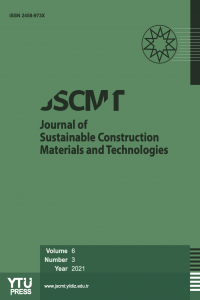The environmental impact evaluation and testing of sustainable inorganic binders: A green alternative to ordinary Portland cement
The environmental impact evaluation and testing of sustainable inorganic binders: A green alternative to ordinary Portland cement
Sustainable alternative constituents to cement are required to reduce its detrimental impact on the environment. This study
___
- 1. Middendorf, B., Martirena, J. F., Gehrke, M., and Day, R. L. (2005) ‘Lime pozzolan binders: An alternative to OPC’. International Building Lime Symposium Proceedings. 9-11 March. Orlando, FL.
- 2. Gutt, W. (1971) Manufacture of cement from industrial by-products. Garston, England: Building Research Station.
- 3. Tsakiridis, P. E., Papadimitriou, G. D., Tsivilis, S., and Koroneos, C. (2008) ‘Utilization of steel slag for Portland cement clinker production’, Journal of Hazardous Materials, 152, pp. 805-811.
- 4. Conner, J. R. and Hoeffner, S. L. (1998b) ‘The history of Stabilisation/solidification technology’, Critical Reviews in Environmental Science and Technology, 28(4), pp. 325-396.
- 5. American Society for Testing and Materials (ASTM) (1989a) ASTM C 150-89 - Standard specification for Portland cement. Philadelphia, PA: ASTM (replaced by ASTM C 618-12 in 2012).
- 6. American Society for Testing and Materials (ASTM) (1989b) ASTM C 618-89 - Standard specification for fly ash and raw - or calcinate natural pozzolans for use as a mineral admixture in Portland cement concrete. Philadelphia, PA: ASTM (replaced by ASTM C150/150M-12 in 2012).
- 7. Conner, J. R. (1990) Chemical Fixation and Solidification of Hazardous Wastes. New York: Van Nostrand Reinhold.
- 8. British Standards Institution (2001) BS EN 459-1:2001 Building Lime: Definitions, Specifications and Conformity Criteria. London: BSI, replaced by BS EN 459-1:2010.
- 9. Environment Agency (2004) EA NEN 7375:2004 Leaching Characteristics of Moulded or Monolithic Building and Waste Materials. Determination of Leaching of Inorganic Components with the Diffusion Test. ‘The tank test’ Based on the translation of the Netherlands Normalisation Institute Standard, Version 1.0, Environment Agency, UK.
- 10. Shi, C., Stegemann, J. A., Caldwell, R. J. (1997) ‘An examination of interference in waste solidification through measurement of heat signature’, Waste Management, 17(4), pp. 249-255.
- 11. Skvara, F., Kastanek, F., Pavelkova, I., Solvoca, O., Maleterova, Y., and Schneider, P. (2002) ‘Solidification of waste steel foundry dust with Portland cement’, Journal of Hazardous Materials, 89, pp. 67-81.
- 12. De Vargas, A. S., Masuero, A. ., and Vilela, A. C. F. (2006) ‘Investigations on the use of electric-arc furnace dust (EAFD) in pozzolan-modified Portland cement I (MP) pastes’, Cement and Concrete Research, 36, pp. 1833-1841.
- 13. Andres, A. and Irabien, J.A. (1994b) ‘The influence of binder/waste ratio on leaching characteristics of solidified/stabilized steel foundry dusts’, Environmental Technology, 15, pp. 343-351.
- 14. Bayuaji R., Kurniawan R.W., Yasin A.K., Fatoni HAT, Lutfi FMA, The effect of fly ash and coconut fibre ash as cement replacement materials on cement paste strength, International Conference on Innovation in Engineering and Vocational Education, Materials Science and Engineering, 128, 2016, IOP Publishing.
- 15. Stegemann, J. A. and Cote, P. L. (1996) ‘A proposed protocol for evaluation of solidified wastes’, Science of the Total Environment, 178, pp. 103-110.
- 16. Andres, A. and Irabien, J. A. (1994a) ‘Solidification/stabilization process for steel foundry dust using cement-based binders: Influence of processing variables’, Waste Management & Research, 12, pp. 405-415.
- 17. Irabien, J. A., Fernandez-Olmo, I., Andres, A., and Sebastia, M. (2002) ‘Prediction of TCLP leachates of electric arc furnace dust/cement products using neural network analysis’, Environmental Progress, 21, pp. 95-104.
- 18. Fernandez, A. I., Chimenos, J. M., Raventos, N., Miralles, L., and Espiell, F. (2003) ‘Stabilisation of electrical arc furnace dust with Low-grade MgO prior to landfill’, Journal of Environmental Engineering, 129, pp. 275-279.
- 19. Salihoglu, G., Pinarli, V., Salihoglu, N. K., and Karaca, G. (2007) ‘Properties of steel foundry electric arc furnace dust solidified/stabilized with Portland cement’, Journal of Environmental Management, 85, pp. 190-197.
- 20. Stegemann, J. A. and Zhou, Q. (2009) ‘Screening tests for assessing treatability of inorganic industrial wastes by stabilisation/solidification with cement’, Journal of Hazardous Materials, 161, pp. 300-306.
- 21. Lim, S., Jeon, W., Lee, L., Lee, K., and Kim, N. (2002) ‘Engineering properties of water/wastewater-treatment sludge modified by hydrated lime, fly ash and loess’, Water Research, 36(17), pp. 4177–4184.
- 22. Oner, A. and Akyuz, S. (2007) ‘An experimental study on optimum usage of GGBS for the compressive strength of concrete’, Cement and Concrete Composites, 29, pp. 505-514.
- 23. Boutouil, M. and Levacher, D. (2005) ‘Effect of high initial water content on cement-based sludge solidification’, Ground Improvement, 9, pp. 169-174. 24. Neville, A. M. (1995) Properties of Concrete, Essex: UK, Addison Wesley Longman Limited.
- 25. Maher A., Najm H., and Boile M. (2005) Solidification/Stabilization of Soft River Sediments Using Deep Soil Mixing. Washington, DC: U.S. Department of Transportation.
- 26. Mehta, P. K. (1989) ‘Pozzolanic and cementitious by-products in concrete - another look’. Proceedings of the 3rd International Conference on Fly Ash, Silica Fume, Natural Pozzolans in Concrete. Trondheim, Norway, pp. 1-43.
- 27. Bijen, J. and Niël, E. (1981) ‘Supersulphated cement from blast furnace slag and chemical gypsum available in the Netherlands and neighbouring countries’, Cement and Concrete Research, 11, pp. 307-322.
- 28. Dermatas, D. and Moon, D. H. (2006) ‘Chromium leaching and immobilization in treated soils’, Environmental Engineering Science, 23(1), pp. 77-87.
- 29. British Standards Institution (2002) BS EN 12457-3:2002, Characterisation of Waste. Leaching. Compliance Test for Leaching of Granular Waste Materials and Sludges. London: BSI.
- Başlangıç: 2016
- Yayıncı: Yıldız Teknik Üniversitesi
Sayıdaki Diğer Makaleler
Infrastructure Projects In Turkey and Innovative Implementations In Project Management
İskender Eyüp EKİZ, Mehmet Fatih ALTAN
Investigation of Waste Products of Boron and Metakaolin Utilizes
Mikhail MUSHUROV, Orhan CANPOLAT, Mucteba UYSAL, Mukhallad M. AL-MASHHADANİ, Yurdakul AYGÖRMEZ
Nawar ALİ, Orhan CANPOLAT, Mukhallad M. AL-MASHHADANİ, Yurdakul AYGÖRMEZ, Mucteba UYSAL
Mustafa KARAGÖZ, Orhan CANPOLAT, Mukhallad M. AL-MASHHADANİ, Yurdakul AYGÖRMEZ, Mucteba UYSAL
